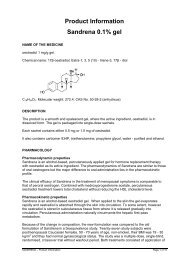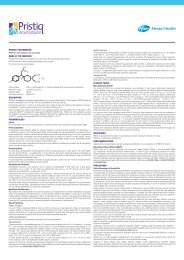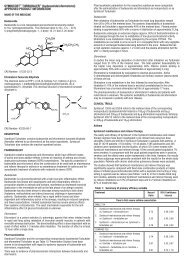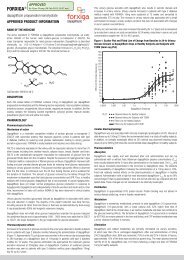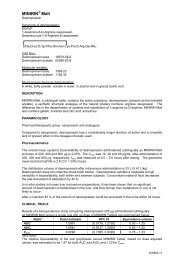Create successful ePaper yourself
Turn your PDF publications into a flip-book with our unique Google optimized e-Paper software.
Nausea (duloxetine 1.3%, placebo 0.5%) was the only common adverse reaction reportedas a reason for discontinuation and considered to be drug-related (i.e., discontinuationoccurring in at least 1% of the duloxetine-treated patients and at a rate of at least twicethat of placebo).Generalised Anxiety Disorder — Approximately 15.3% (102/668) of the patients whoreceived duloxetine in placebo-controlled trials for GAD discontinued treatment due toan adverse reaction, compared with 4.0% (20/495) for placebo. Common adversereactions reported as a reason for discontinuation and considered to be drug-related (asdefined above) included nausea (duloxetine 3.7%, placebo 0.2%), vomiting (duloxetine1.3%, placebo 0.0%), and dizziness (duloxetine 1.0%, placebo 0.2%).Diabetic Peripheral Neuropathic Pain — Approximately 14.3% (81/568) of the patientswho received duloxetine in placebo-controlled trials for DPNP discontinued treatmentdue to an adverse reaction, compared with 7.2% (16/223) for placebo. Common adversereactions reported as a reason for discontinuation and considered to be drug-related (asdefined above) were nausea (duloxetine 3.5%, placebo 0.4%), dizziness (duloxetine1.6%, placebo 0.4%), somnolence (duloxetine 1.6%, placebo 0.0%), and fatigue(duloxetine 1.1%, placebo 0.0%).Adverse Reactions Occurring at an Incidence of 2% or More Among Duloxetine-Treated Patients in Placebo-Controlled TrialsPooled MDD and GAD Trials — Table 5 gives the incidence of treatment-emergentadverse reactions in MDD and GAD placebo-controlled trials that occurred in 2% ormore of patients treated with duloxetine and with an incidence greater than placebo.Cymbalta PI Nov 2012 v8.0 21



